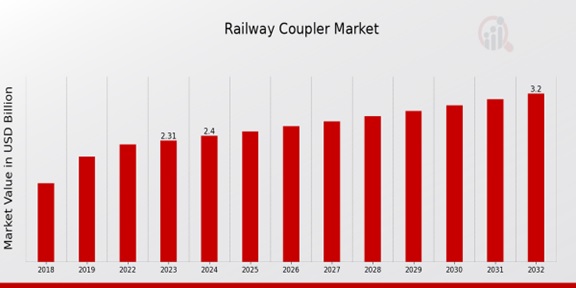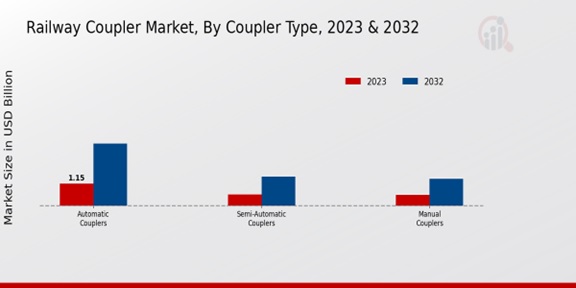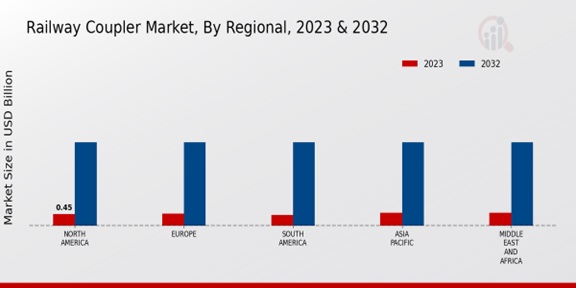Railway Coupler Market Overview
As per MRFR analysis, the Railway Coupler Market Size was estimated at 2.23 (USD Billion) in 2022. The Railway Coupler Market Industry is expected to grow from 2.31(USD Billion) in 2023 to 3.2 (USD Billion) by 2032. The Railway Coupler Market CAGR (growth rate) is expected to be around 3.68% during the forecast period (2024 - 2032).
The Railway Coupler Market is experiencing a surge in demand driven by the increasing adoption of automated train operations, rising infrastructure investments, and the expansion of high-speed rail networks. Governments worldwide prioritize railway infrastructure development to promote sustainable transportation and reduce emissions. This investment surge is creating lucrative opportunities for railway coupler manufacturers.Technological advancements such as automatic couplers and remote-controlled couplers enhance operational efficiency and safety, fueling market growth. Furthermore, the trend towards intermodal transportation and the increasing use of rail freight services are compelling manufacturers to develop couplers that facilitate seamless transitions between different modes of transport. The rise of smart cities and the integration of Internet of Things (IoT) technologies into railway systems present innovative opportunities for couplers with sensing and monitoring capabilities.

Source: Primary Research, Secondary Research, MRFR Database and Analyst Review
Railway Coupler Market Drivers
Increasing Demand for Rail Transportation
The demand for an expanding supply of transport is the primary growth driver for the Railway Coupler Market Industry. As people across the world continue to experience population growth and urbanization, the demand for more efficient, fast, and reliable transport systems has also dramatically increased. Railways have proven to be one of the best options in this regard; railways can carry bulk volume commodities of both freight and passengers and directly fit products such as cars, trucks, and special containers.They are also one of the most energy-efficient transport modes and the convenience of this system outweighs the disadvantage of heavy traffic congestion, which is experienced during peak periods of usage. Due to these advantages, various governments and supply chain companies are heavily investing in their respective railway systems. Couplers are a significant part of any railway, and their market is expected to grow with the growth of the railway industry.
Technological Advancements
Technological advancement is the other driving factor of the industry of the Railway Coupler Market. New designs and types of technological railway couplers are more efficient and safe. An example can be the automatic type that decreases the possibility of accidents and injuries during uncoupling and coupling. The other example is using more quality and durable material types that make couplers more resistant to wear and tear and increase the life span of railway cars and locomotives.Changes in this area make railway transportation cheaper, more reliable, and quick, driving the demand for railway couplers.
Rising Safety Concerns
Additionally, rising safety concerns are also increasing the growth of the Railway Coupler market. Railway couplers are one of the most critical components of any train, as they are used to attach the rolling stock to one another and enable the train to travel in a single straight line. Hence, if a railway coupler fails, there is an imminent risk of accidents and injuries. Additionally, the railway industry is also one of the most regulated industries for the same reason.Several government agencies, as well as private operators, are always under pressure to ensure a safe train operation. Even though there are several coupler manufacturers in the world, railway couplers are often highly regulated and need to meet minimum safety requirements. Hence, the increasing safety concerns are driving the growth of the Railway Coupler Market Industry.
Railway Coupler Market Segment Insights:
Railway Coupler Market Coupler Type Insights
The Coupler Type segment plays a pivotal role in driving the growth trajectory of the Railway Coupler Market. The segment encompasses three distinct categories: Automatic Couplers, Semi-Automatic Couplers, and Manual Couplers. Automatic couplers have emerged as the dominant force within the Coupler Type segment, accounting for a substantial share of the Railway Coupler Market revenue. These couplers are highly sought after due to their ability to connect and disconnect railway vehicles automatically, significantly enhancing operational efficiency and safety.The widespread adoption of automatic couplers in high-speed rail networks and modern railway systems has propelled their market dominance. Semi-Automatic Couplers: Semi-automatic couplers offer a balance between automation and manual operation.
They require minimal human intervention during the coupling process, reducing the risk of accidents and injuries. Semi-automatic couplers have gained traction in regional railways and freight transportation, where cost-effectiveness and operational efficiency are key considerations. Manual Couplers: Manual couplers, while less prevalent in modern railway systems, continue to hold a presence in certain applications.They are primarily employed in heritage railways, industrial settings, and remote locations where automation is not feasible or cost-effective. Manual couplers require skilled operators and involve a higher degree of risk compared to automatic or semi-automatic counterparts. The Railway Coupler Market segmentation offers insights into the diverse needs and preferences of the railway industry. Each Coupler Type segment caters to specific operational requirements, safety considerations, and cost constraints. Automatic couplers lead the market with their advanced functionality and safety features, while semi-automatic and manual couplers fulfill niche applications.

Source: Primary Research, Secondary Research, MRFR Database and Analyst Review
Railway Coupler Market Application Insights
The application segment is a crucial aspect of the Railway Coupler Market segmentation. It categorizes the market based on the different types of railway vehicles that utilize couplers. Key applications in this segment include freight trains, passenger trains, locomotives, and shunting vehicles. Freight Trains: The largest application segment, freight trains, is anticipated to maintain its dominance throughout the forecast period. The increasing demand for efficient and reliable transportation of goods across long distances is driving market growth in this segment. Passenger Trains: Passenger trains constitute a significant portion of the market, with a growing focus on enhancing passenger safety and comfort.
The expansion of high-speed rail networks and the increasing number of passenger rail journeys are contributing to the segment's growth. Locomotives: Locomotives, which provide the motive power for trains, represent a substantial market segment. The rising demand for locomotives in developing countries and the replacement of aging fleets in developed regions are key growth drivers. Shunting Vehicles: Shunting vehicles, used for maneuvering railway cars in yards and terminals, represent a niche but important segment.The increasing adoption of automated shunting systems and the need for efficient yard operations are driving demand in this segment.
Railway Coupler Market Material Insights
The Material segment of the Railway Coupler Market is expected to witness steady growth in the coming years, driven by the increasing demand for lightweight and durable couplers in the railway industry. Steel is the most commonly used material for railway couplers owing to its high strength and low cost. Alloy steel couplers are also gaining popularity due to their superior strength-to-weight ratio and resistance to wear and tear. Composite materials, such as fiberglass and carbon fiber, are emerging as promising alternatives to traditional materials due to their lightweight and high-strength properties.The Railway Coupler Market revenue for the Material segment is projected to reach USD 1.57 billion by 2026, exhibiting a CAGR of 4.2% during the forecast period 2023-2026.
Railway Coupler Market Coupling Mechanism Insights
The Railway Coupler Market is segmented based on Coupling Mechanism into Screw Couplings, Pin and Plate Couplings, and Slackless Couplings. Among these segments, Slackless Couplings is expected to hold the largest market share of around 40% by 2027, owing to its ability to provide a more secure and efficient connection between railway cars. Screw Couplings are expected to witness a steady growth rate during the forecast period due to their simplicity and cost-effectiveness. Pin and Plate Couplings, on the other hand, are anticipated to have a moderate market presence due to their limited application in certain types of railway operations.The Railway Coupler Market is expected to reach a value of USD 2.9 billion by 2027, expanding at a CAGR of 3.8%.
Railway Coupler Market Regional Insights
The Railway Coupler Market revenue is segmented into different regions, namely North America, Europe, APAC, South America, and MEA. North America is expected to hold a significant share of the global market owing to the presence of well-established railway infrastructure and increasing demand for efficient and reliable railway couplers. The European region is also expected to contribute a substantial share of the global market due to the presence of a large railway network and stringent regulations regarding railway safety. The APAC region is anticipated to witness significant growth in the railway coupler market due to the rapid expansion of railway infrastructure and increasing investments in railway projects.South America and MEA regions are expected to have a moderate market share, with potential for growth in the coming years due to increasing railway connectivity and infrastructure development.

Source: Primary Research, Secondary Research, MRFR Database and Analyst Review
Railway Coupler Market Key Players And Competitive Insights:
The industry of Railway Coupler Market is fairly competitive. major leading Railway Coupler Market companies are Dellner, Wabtec, Alstom, and Knorr-Bremse, among others. Moreover, the railway coupler market's emerging trends have been witnessed in the last few years due to the development of manufacturers focusing on research and development to offer better quality couplers and gain a sizable market share. The Railway Coupler Market Competitive Landscape also consists of many players who are gradually focusing on adopting strategies, namely, acquisitions, mergers, Joint Ventures, investments, and others to raise the existing competition in the market.
AAM is one of the companies operating in the Railway Coupler Market. The company provides coupler for every market and strives to provide services that are tailored to meet client needs. Its couplers provide superior performance and customer value. The company has been operating in the market since 2002 and sells its products to a wide range of customers in the rail industry. Riley has manufacturing facilities in the United States, Mexico and Germany. The company has R&D activity and is responsible for a number of innovations and project sales. Another leading contender in the Railway Coupler Market is Amsted Rail. The coupler industry provides a range of coupler products for freight and passenger trains and has a long history. These offerings are of high quality and performance. Amste Rail is preoccupied with advancing customer service, and an expert team is available to assist. The company has plants in North America, Europe and Asia. The production facilities of this manufacturer are distinguished by a strong track record and skilled engineers. The company invests money in product development in order to comply with the most up-to-date safety and performance standards.
Key Companies in the Railway Coupler Market Include:
- Wabtec
- Amsted Rail
- Canadian Pacific Railway
- Genesee Wyoming
- CN
- Ferromex
- BNSF Railway
- CSX Transportation
- Norfolk Southern
- Canadian National Railway
- RailAmerica
- CP
- Union Pacific
- Kansas City Southern
- Trinity Industries
Railway Coupler Market Segmentation Insights
Railway Coupler Market Coupler Type Outlook
- Automatic Couplers
- Semi-Automatic Couplers
- Manual Couplers
Railway Coupler Market Application Outlook
- Freight Trains
- Passenger Trains
- Locomotives
- Shunting Vehicles
Railway Coupler Market Material Outlook
- Steel
- Alloy Steel
- Composite Materials
Railway Coupler Market Coupling Mechanism Outlook
- Screw Couplings
- Pin and Plate Couplings
- Slackless Couplings
Railway Coupler Market Regional Outlook
- North America
- Europe
- South America
- Asia Pacific
- Middle East and Africa
| Report Attribute/Metric |
Details |
| Market Size 2022 |
2.23(USD Billion) |
| Market Size 2023 |
2.31(USD Billion) |
| Market Size 2032 |
3.2(USD Billion) |
| Compound Annual Growth Rate (CAGR) |
3.68% (2024 - 2032) |
| Report Coverage |
Revenue Forecast, Competitive Landscape, Growth Factors, and Trends |
| Base Year |
2023 |
| Market Forecast Period |
2024 - 2032 |
| Historical Data |
2019 - 2023 |
| Market Forecast Units |
USD Billion |
| Key Companies Profiled |
Wabtec, Amsted Rail, Canadian Pacific Railway, Genesee Wyoming, CN, Ferromex, BNSF Railway, CSX Transportation, Norfolk Southern, Canadian National Railway, RailAmerica, CP, Union Pacific, Kansas City Southern, Trinity Industries |
| Segments Covered |
Coupler Type, Application, Material, Coupling Mechanism, Regional |
| Key Market Opportunities |
Increasing demand for highspeed rail networks Government initiatives for railway infrastructure development Growing need for efficient and safe rail transportation Technological advancements in coupler designs Emphasis on freight transportation efficiency |
| Key Market Dynamics |
Technological advancements Growing demand for high-speed rail Government initiatives Increasing safety regulations Intensifying competition |
| Countries Covered |
North America, Europe, APAC, South America, MEA |
Frequently Asked Questions (FAQ) :
The Railway Coupler Market is expected to reach a valuation of USD 3.2 billion by 2032, expanding at a CAGR of 3.68% from 2024 to 2032.
Asia-Pacific is anticipated to hold the largest market share over the forecast period due to the increasing development of railway infrastructure in countries like China, India, and Japan.
Railway couplers are primarily used in passenger trains, freight trains, and locomotives. They ensure the safe and efficient connection of railway vehicles.
Prominent players in the Railway Coupler Market include Wabtec Corporation, Amsted Rail, Buckeye Partners, and GE Transportation.
Rising demand for efficient and reliable rail transportation, increasing investments in railway infrastructure, and technological advancements in coupler design are driving the growth of the railway coupler market.
Fluctuating raw material prices, stringent regulatory requirements, and intense competition from alternative transportation modes pose challenges to the railway coupler market.
Advances in automation and digitalization, the development of lightweight and energy-efficient couplers, and the adoption of condition monitoring systems are emerging trends in the railway coupler market.
The COVID-19 pandemic had a moderate impact on the railway coupler market due to disruptions in supply chains and reduced demand for rail transportation. However, the market is expected to recover as economic activities resume.
Factors such as raw material costs, manufacturing complexity, technological advancements, and the competitive landscape influence the pricing of railway couplers.
Growing demand for rail freight transportation, government initiatives to promote rail infrastructure development, and the expansion of railway networks in emerging economies present growth opportunities for the railway coupler market.

















